.
FRANCE 2012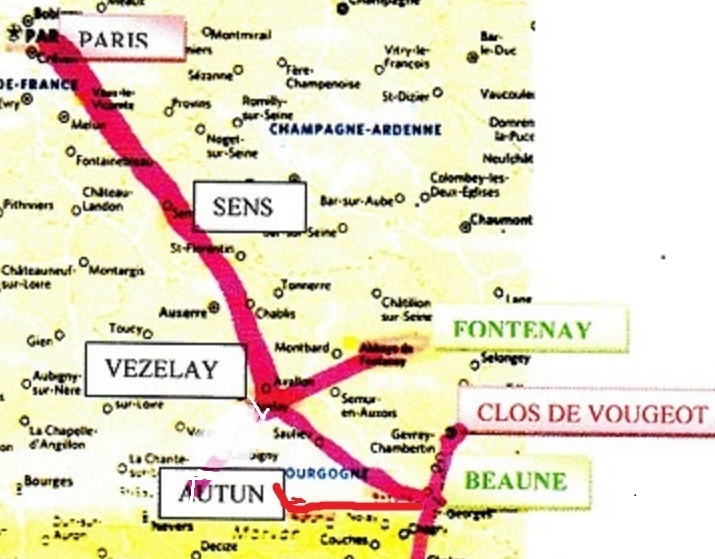
DAY 6, SATURDAY, SEPT.8
BEAUNE, AUTUN, CITEAUX,
CLOS DE VOUGEOT
We slept a little late this morning because the maids, who tu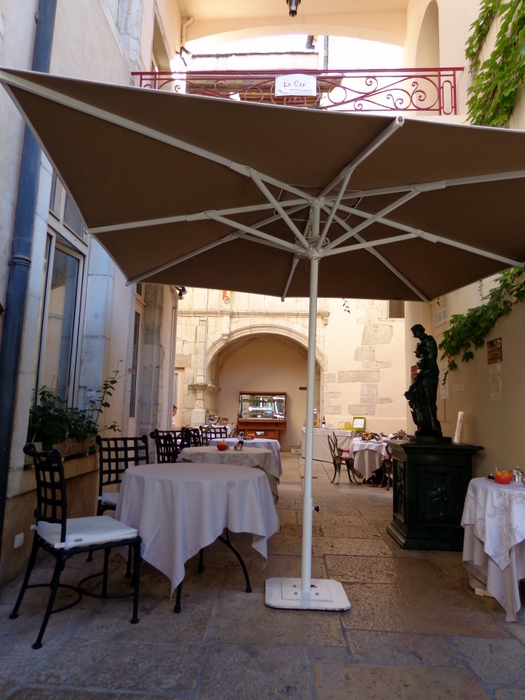 rned
down our bed last night, closed the shutters on our window…they are on
the outside. At 7:00 it was very dark in our room. We finally got up
and went to breakfast downstairs…it was outside in the courtyard.
Breakfast was cereals, meats, cheese, fruits, figs, and breads. They
did have hard boiled eggs already cooked.
rned
down our bed last night, closed the shutters on our window…they are on
the outside. At 7:00 it was very dark in our room. We finally got up
and went to breakfast downstairs…it was outside in the courtyard.
Breakfast was cereals, meats, cheese, fruits, figs, and breads. They
did have hard boiled eggs already cooked. 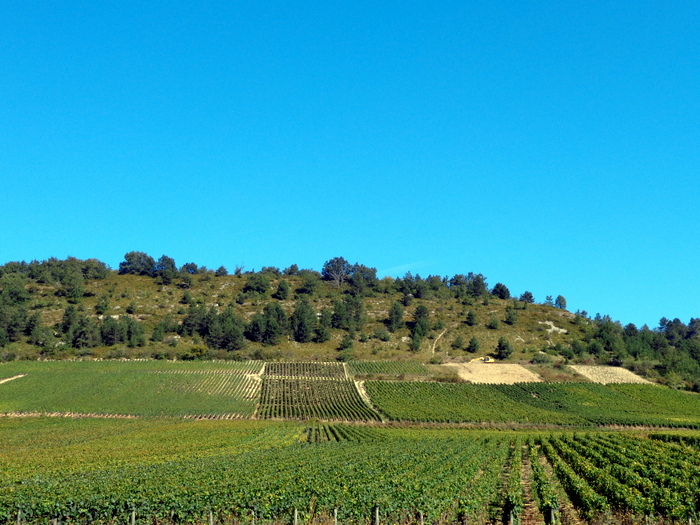
We left at 11:00 and headed
to Autun, about an hour drive west. It is on narrow roads through some
beautiful vineyards and quaint little villages of 4-6 houses. Since
Sens, we have been in Burgundy – the wine country. Many of the local
wines are named after the little villages. Ever since we have been in
this area, we have seen many, many white cows grazing. There was
nowhere to stop and take a picture but they are wonderful to see. We
have new maps on our GPS, and one of the new features is a sound when
you exceed the speed limit- the one that we have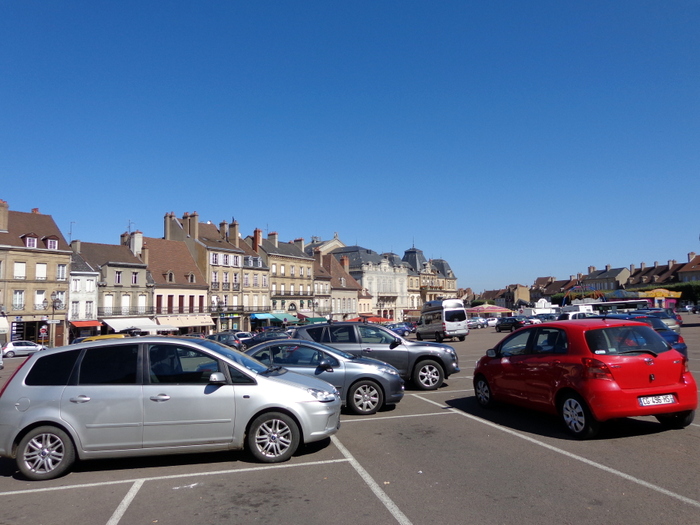 chosen is a cow
mooing, so we laugh every time we don’t slow down enough going through
these little settlements and we see the white cows and hear “them”
mooing in our car.
chosen is a cow
mooing, so we laugh every time we don’t slow down enough going through
these little settlements and we see the white cows and hear “them”
mooing in our car.
We arrived at noon in Autun, and the first thing that we saw was a
McDonalds, so we stopped for lunch. Autun is a quaint town of 15,000.
We parked in the town center lot.
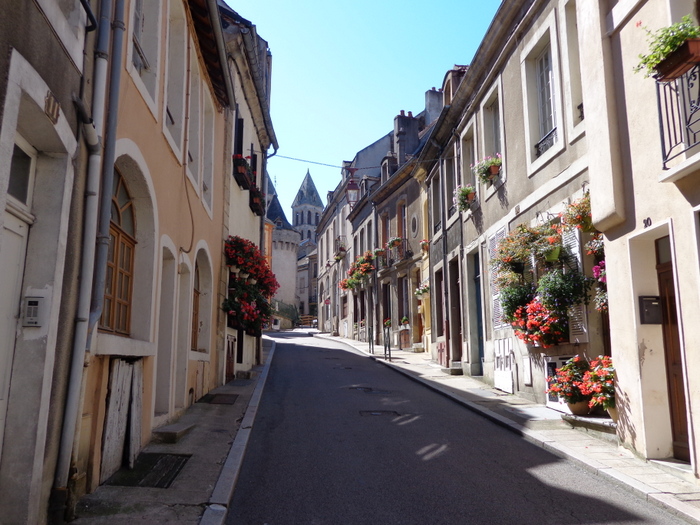
We hiked many blocks up the hill past
a number of shops on both sides of the street to the Cathedral. This
cathedral is famous for the tympanum (statues) over the center front
door.
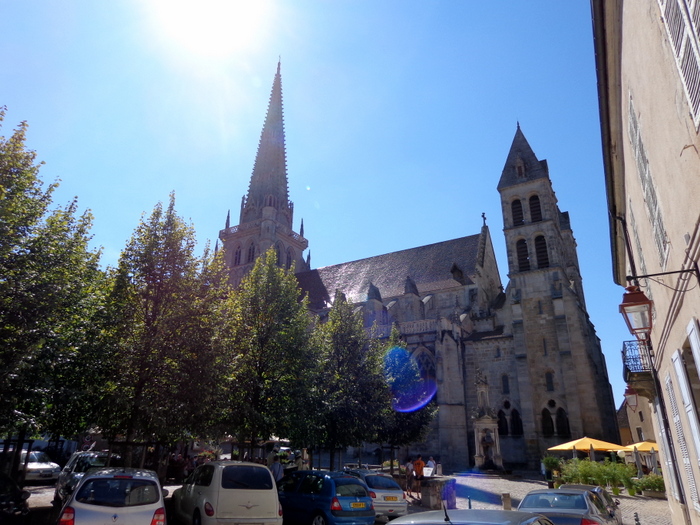 In the 13th century, Etienne de Bage, to avoid the possibility of
conflict with Vezelay, decided to build a church for pilgrims dedicated
to St. Lazarus, brother of Mary Magdalene whose relics were in Vezelay,.
The relics of St. Lazarus were present at the Cathedral since the 10th
century. At this time in history pilgrims were extremely widespread, and
a new location for pilgrimage on the way to San Juan de Compostela not
far from Vezelay, was the obvious thing to create.
In the 13th century, Etienne de Bage, to avoid the possibility of
conflict with Vezelay, decided to build a church for pilgrims dedicated
to St. Lazarus, brother of Mary Magdalene whose relics were in Vezelay,.
The relics of St. Lazarus were present at the Cathedral since the 10th
century. At this time in history pilgrims were extremely widespread, and
a new location for pilgrimage on the way to San Juan de Compostela not
far from Vezelay, was the obvious thing to create.
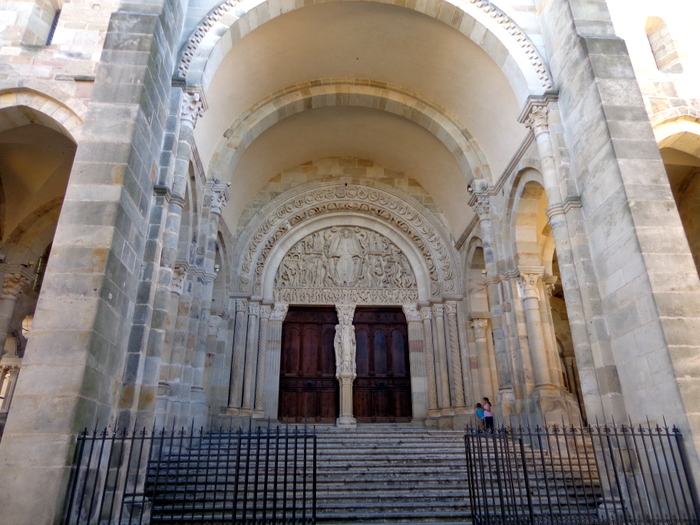
The building work was completed extremely quickly and by 1146 the
entire structure was finished, with the exception of the porch which was
added a few years later. The remarkable spire was built in the late 15th
century, lightning having destroyed the original Roman tower of which no
trace nor even a drawing, now remains. The 14 chapels which lined both
sides of the nave were built in the 16th century. The two towers and the
portico were built in the late 12th century, the towers being modified
in the 18th century, and
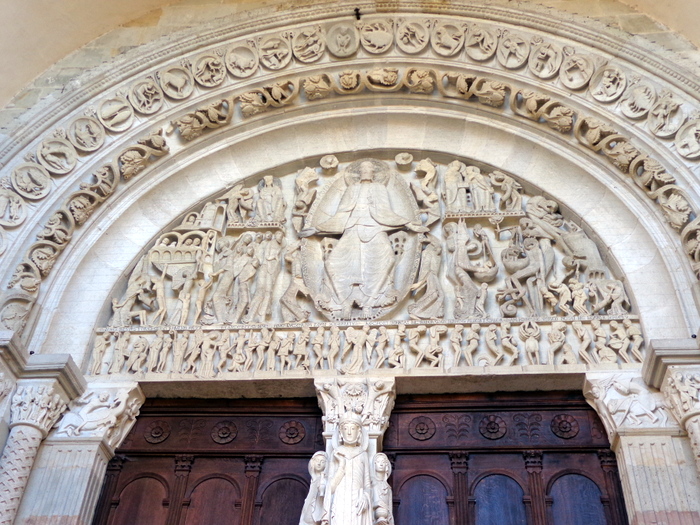 partially rebuilt in the 19th century on the
model of the towers at Paray le Monial.
partially rebuilt in the 19th century on the
model of the towers at Paray le Monial.
The imposing porch housing the tympanum of the Last Judgment is the
most remarkable aspect of the entire Cathedral.
This tympanum is signed
by the sculptor: Gislebertus hoc fecit
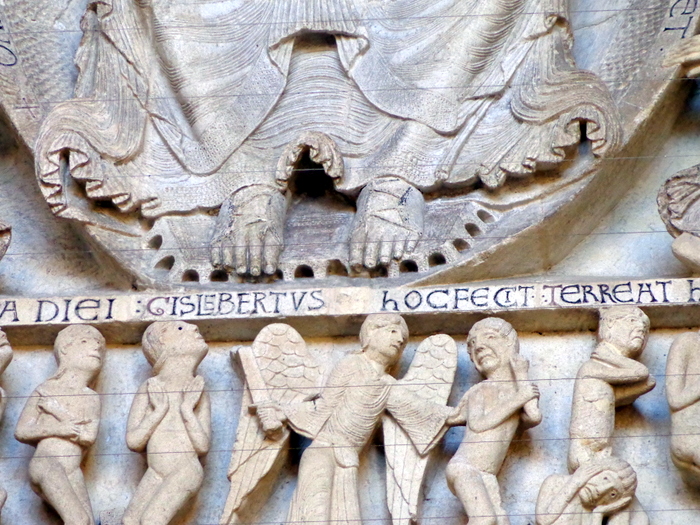 (Gislebert made this). The
signature can be seen clearly below the feet of Christ in Majesty.
Nothing more is known of Gislebert, apart from the fact that he came
from Vezelay, as many sculptures there bear his name. The style of the
sculpture was not always appreciated during the successive centuries. In
1766, the canons decided that the carvings were mediocre and childish,
and had the tympanum filled with a layer of plaster without realizing
that by doing so, they would preserve this work of art from vandalism
during the French Revolution,. In 1837 another priest had the
inspiration to scratch away the plaster and found the original tympanum
in a perfect state of conservation. The head of Christ was missing. It
is said that being in relief, it had hindered the work of the plasterers
so they simply whacked it off. It ended up in the Rolin Museum in
Vezelay. It was finally replaced in his original position in 1948.
(Gislebert made this). The
signature can be seen clearly below the feet of Christ in Majesty.
Nothing more is known of Gislebert, apart from the fact that he came
from Vezelay, as many sculptures there bear his name. The style of the
sculpture was not always appreciated during the successive centuries. In
1766, the canons decided that the carvings were mediocre and childish,
and had the tympanum filled with a layer of plaster without realizing
that by doing so, they would preserve this work of art from vandalism
during the French Revolution,. In 1837 another priest had the
inspiration to scratch away the plaster and found the original tympanum
in a perfect state of conservation. The head of Christ was missing. It
is said that being in relief, it had hindered the work of the plasterers
so they simply whacked it off. It ended up in the Rolin Museum in
Vezelay. It was finally replaced in his original position in 1948.
It is not possible get a complete frontal view of cathedral because
it sits on a very narrow street with buildings on the other side of the
street.
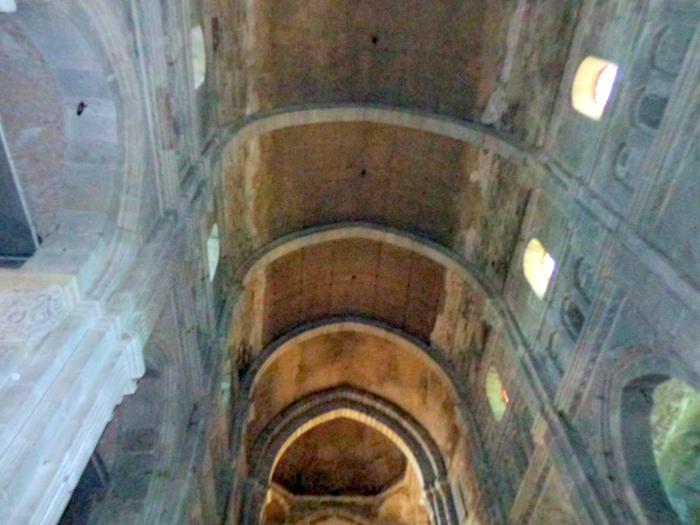 On the interior, the shape of the vaulting and the fluting applied
to the pillars are rather different from other churches of the time. The
vaulting is not Gothic. There are no cross diagonal ribs. It is an
equilateral form of semicircular Roman vaulting widely used from the
late 11th century by the Cistercians in Cluny. Wanting to ensure direct
lighting of the nave, they built the side aisles of very low elevation
On the interior, the shape of the vaulting and the fluting applied
to the pillars are rather different from other churches of the time. The
vaulting is not Gothic. There are no cross diagonal ribs. It is an
equilateral form of semicircular Roman vaulting widely used from the
late 11th century by the Cistercians in Cluny. Wanting to ensure direct
lighting of the nave, they built the side aisles of very low elevation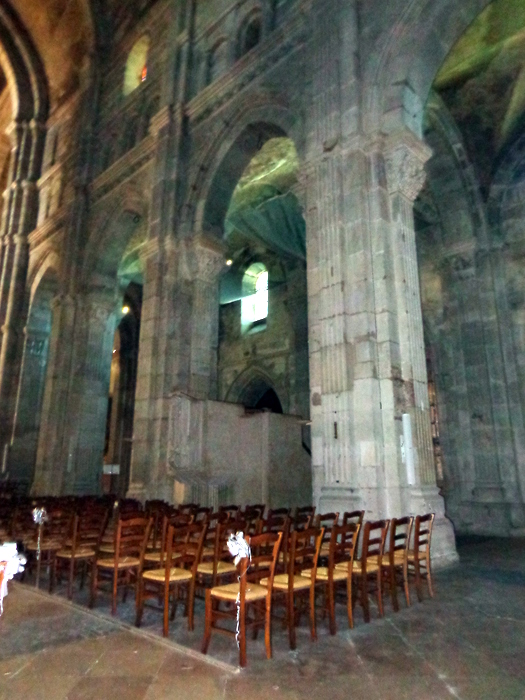 compared to the principle vaulting. Flying buttresses had not yet been
invented, so the side aisles acted as buttresses. Flying buttresses were
added in the 13th century. The upper part of the choir was rebuilt in
this 15th century following the collapse of the Roman tower which was
struck by lightning. There are amazing carvings on the capitals of the
pillars.
compared to the principle vaulting. Flying buttresses had not yet been
invented, so the side aisles acted as buttresses. Flying buttresses were
added in the 13th century. The upper part of the choir was rebuilt in
this 15th century following the collapse of the Roman tower which was
struck by lightning. There are amazing carvings on the capitals of the
pillars.
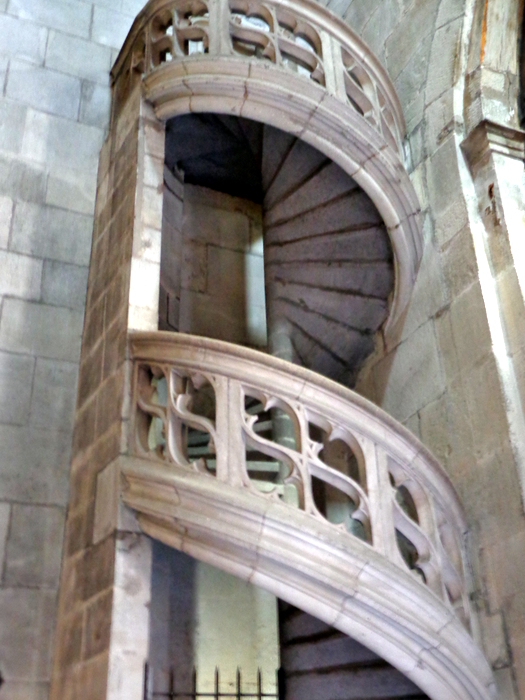
The interior was rather dark and difficult to photograph. On the
north wall near the choir, there is a elegant 15th century stone
circular staircase which leads to the belfry. It is not open to
visitors.
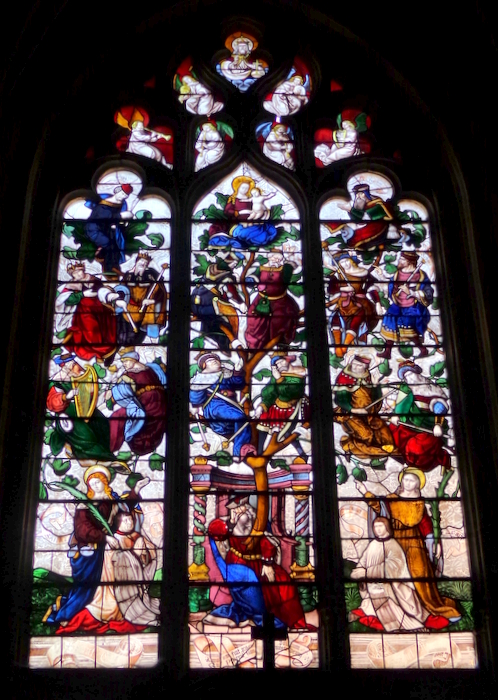
One of the north side a 15th century chapel contained the only
remaining in the stained-glass window in the Cathedral. Dating from
1515, it shows the Tree of Jesse, the family tree of Christ. Jesse, the
father of David, sits in the central lower part of the wind. The tree
grows from his tunic, and his descendents appear as branches.
We spent about 2 hours in Autun.
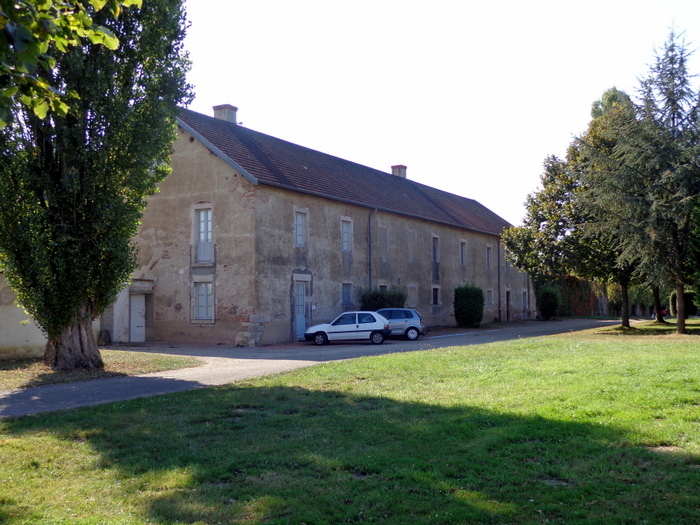 We drove back, going around Beaune, about a half hour to Abbaye
Citeaux which was founded in 1098 by Robert of Molesme. The Abbey of
Cîteaux is the birthplace of the Cistercian Order. Begun in great
poverty, the community flourished, thanks to the arrival of Saint
Bernard and his companions in the spring of 1113.
We drove back, going around Beaune, about a half hour to Abbaye
Citeaux which was founded in 1098 by Robert of Molesme. The Abbey of
Cîteaux is the birthplace of the Cistercian Order. Begun in great
poverty, the community flourished, thanks to the arrival of Saint
Bernard and his companions in the spring of 1113.
Two years later, Bernard, at the head of 12 monks, was sent to found
Clairvaux. In the following 30 years, the abbot would see his community
grow to nearly 500 brothers. By means of his writings and their
influence, Saint Bernard would be the source of a veritable school of
spirituality with which the Cistercians continue to be nourished to this
day. At the end of the 12th century, the Order had
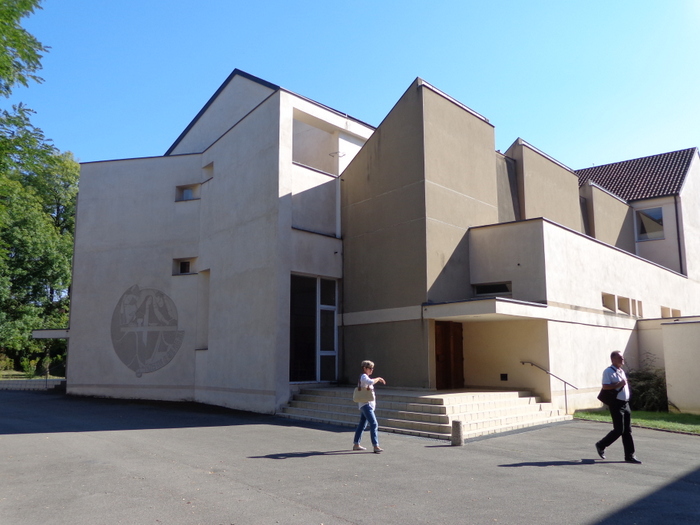 more than 500
monasteries. Interrupted for 100 years by the Revolution, monastic life
was re-established at Cîteaux in 1898.
more than 500
monasteries. Interrupted for 100 years by the Revolution, monastic life
was re-established at Cîteaux in 1898.
Today, a community of 35 brothers give themselves to prayer and to work,
living under the Rule of Saint Benedict .
 Cîteaux and had undergone a lot of modernization in the last few years
with a very modern chapel. They offered tours in French, not English,
and the next was from 5:00 to 6:15 so we decided not to stay because we
had one other place we really wanted to see, and we had an 8:00 dinner
reservation.
Cîteaux and had undergone a lot of modernization in the last few years
with a very modern chapel. They offered tours in French, not English,
and the next was from 5:00 to 6:15 so we decided not to stay because we
had one other place we really wanted to see, and we had an 8:00 dinner
reservation.
We left Cîteaux and drove about 20 minutes to the Chate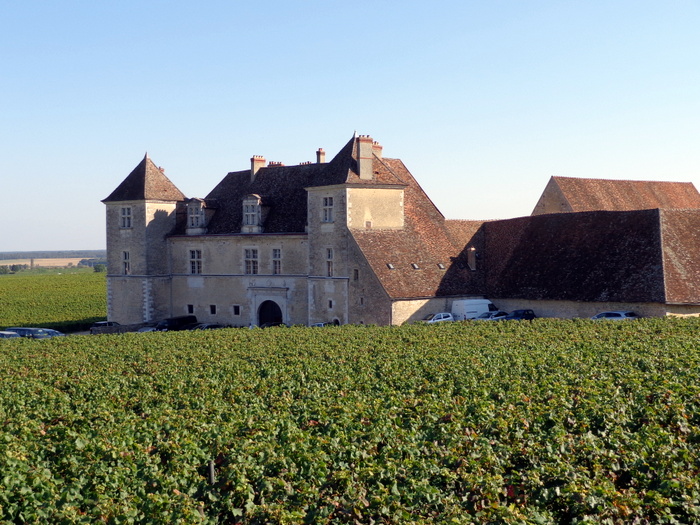 au du Clos de
Vougeot. I had especially wanted to see this because it was one of my
RECENT MODELS. It is a very small model. The Chateau was off the main
road, and as we approached we saw hundreds of cars parked everywhere.
We finally found a place to park and walked some distance to the
entrance. It was closed (shucks) because of a wedding, but we could
look around the outside and take photos. Standing in the very heart of
Burgundy’s vineyards, it was originally a wine farm, built in the 12th
century by monks from the nearby Abbey of Cîteaux. In the 16th century,
a Renaissance style château was added to the existing buildings.
au du Clos de
Vougeot. I had especially wanted to see this because it was one of my
RECENT MODELS. It is a very small model. The Chateau was off the main
road, and as we approached we saw hundreds of cars parked everywhere.
We finally found a place to park and walked some distance to the
entrance. It was closed (shucks) because of a wedding, but we could
look around the outside and take photos. Standing in the very heart of
Burgundy’s vineyards, it was originally a wine farm, built in the 12th
century by monks from the nearby Abbey of Cîteaux. In the 16th century,
a Renaissance style château was added to the existing buildings.
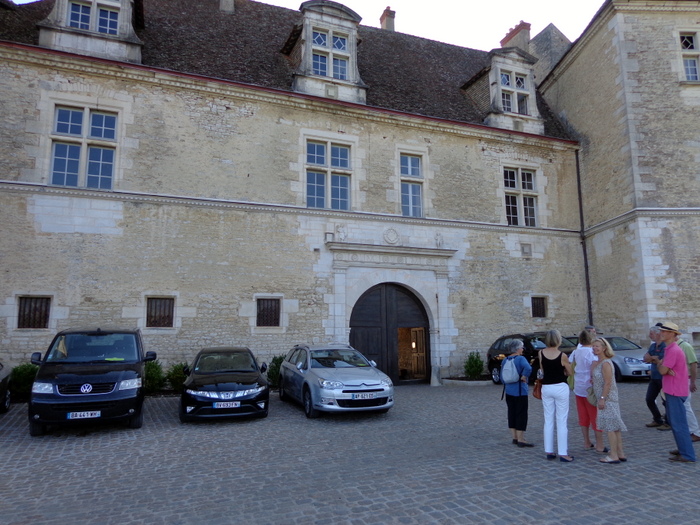 With its medieval vat-house and presses, Cistercian cellar and original
kitchens, it forms a unique architectural whole, attracting history
lovers, architecture lovers and wine lovers. The Chateau du Clos de
Vougeot also hosts famous receptions.
With its medieval vat-house and presses, Cistercian cellar and original
kitchens, it forms a unique architectural whole, attracting history
lovers, architecture lovers and wine lovers. The Chateau du Clos de
Vougeot also hosts famous receptions.
Chateau du Clos de Vougeot does not produce wine anymore, but stays the
symbol of Burgundy’s History. In 1934 a small group of Burgundians met
in a celler in Nuits–St–Georges, and decided to form a society whose aim
was to promote the wines of France in general and, in particular,
Burgundy wines. The brotherhood was born and its renown spread
throughout Europe and America.
The Château was built in the Renaissance and restored in the 19th
century. The Confrérie des Chevaliers du Tastevin acquired the Château
in 1945, and started to restore it, turning it into the seat of the
Order. It was wonderful to visit that even if we could not get in.
When we got back to the hotel, the desk clerk ask about our day. We told
her about the cars at Chateau du Clos de Vougeot, and she said it the
marriage of the daughter of the lady who owns the restaurant where we
were having dinner. She said that there had been about 500 people
invited. It was the first time in its history that it had been closed
for a private function. And, of course, it was the day we visited!
We stopped in the courtyard and had a drink before going to the room.
The adjacent restaurant, Loiseau des Vignes, is very famous. The owner
has two more restaurants in Paris and one in another part of France.
Our dinner was unbelievable. The tables were nicely spaced, and those
present were there for the entire evening. Even though it was six
courses each with its own wine, none of the courses were of very large,
but they were delicious. They allowed a lot of time between courses. I
would describe each course to you but it was 11: 45 when we got back to
our room and unfortunately I did not write it down. I am editing my
notes and posting our days adventure three years after the event.
Unfortunately neither my wife or I can remember what we ate – but the
entire experience was very memorable.

 rned
down our bed last night, closed the shutters on our window…they are on
the outside. At 7:00 it was very dark in our room. We finally got up
and went to breakfast downstairs…it was outside in the courtyard.
Breakfast was cereals, meats, cheese, fruits, figs, and breads. They
did have hard boiled eggs already cooked.
rned
down our bed last night, closed the shutters on our window…they are on
the outside. At 7:00 it was very dark in our room. We finally got up
and went to breakfast downstairs…it was outside in the courtyard.
Breakfast was cereals, meats, cheese, fruits, figs, and breads. They
did have hard boiled eggs already cooked. 
 chosen is a cow
mooing, so we laugh every time we don’t slow down enough going through
these little settlements and we see the white cows and hear “them”
mooing in our car.
chosen is a cow
mooing, so we laugh every time we don’t slow down enough going through
these little settlements and we see the white cows and hear “them”
mooing in our car. 
 In the 13th century, Etienne de Bage, to avoid the possibility of
conflict with Vezelay, decided to build a church for pilgrims dedicated
to St. Lazarus, brother of Mary Magdalene whose relics were in Vezelay,.
The relics of St. Lazarus were present at the Cathedral since the 10th
century. At this time in history pilgrims were extremely widespread, and
a new location for pilgrimage on the way to San Juan de Compostela not
far from Vezelay, was the obvious thing to create.
In the 13th century, Etienne de Bage, to avoid the possibility of
conflict with Vezelay, decided to build a church for pilgrims dedicated
to St. Lazarus, brother of Mary Magdalene whose relics were in Vezelay,.
The relics of St. Lazarus were present at the Cathedral since the 10th
century. At this time in history pilgrims were extremely widespread, and
a new location for pilgrimage on the way to San Juan de Compostela not
far from Vezelay, was the obvious thing to create.

 partially rebuilt in the 19th century on the
model of the towers at Paray le Monial.
partially rebuilt in the 19th century on the
model of the towers at Paray le Monial. (Gislebert made this). The
signature can be seen clearly below the feet of Christ in Majesty.
Nothing more is known of Gislebert, apart from the fact that he came
from Vezelay, as many sculptures there bear his name. The style of the
sculpture was not always appreciated during the successive centuries. In
1766, the canons decided that the carvings were mediocre and childish,
and had the tympanum filled with a layer of plaster without realizing
that by doing so, they would preserve this work of art from vandalism
during the French Revolution,. In 1837 another priest had the
inspiration to scratch away the plaster and found the original tympanum
in a perfect state of conservation. The head of Christ was missing. It
is said that being in relief, it had hindered the work of the plasterers
so they simply whacked it off. It ended up in the Rolin Museum in
Vezelay. It was finally replaced in his original position in 1948.
(Gislebert made this). The
signature can be seen clearly below the feet of Christ in Majesty.
Nothing more is known of Gislebert, apart from the fact that he came
from Vezelay, as many sculptures there bear his name. The style of the
sculpture was not always appreciated during the successive centuries. In
1766, the canons decided that the carvings were mediocre and childish,
and had the tympanum filled with a layer of plaster without realizing
that by doing so, they would preserve this work of art from vandalism
during the French Revolution,. In 1837 another priest had the
inspiration to scratch away the plaster and found the original tympanum
in a perfect state of conservation. The head of Christ was missing. It
is said that being in relief, it had hindered the work of the plasterers
so they simply whacked it off. It ended up in the Rolin Museum in
Vezelay. It was finally replaced in his original position in 1948.  On the interior, the shape of the vaulting and the fluting applied
to the pillars are rather different from other churches of the time. The
vaulting is not Gothic. There are no cross diagonal ribs. It is an
equilateral form of semicircular Roman vaulting widely used from the
late 11th century by the Cistercians in Cluny. Wanting to ensure direct
lighting of the nave, they built the side aisles of very low elevation
On the interior, the shape of the vaulting and the fluting applied
to the pillars are rather different from other churches of the time. The
vaulting is not Gothic. There are no cross diagonal ribs. It is an
equilateral form of semicircular Roman vaulting widely used from the
late 11th century by the Cistercians in Cluny. Wanting to ensure direct
lighting of the nave, they built the side aisles of very low elevation compared to the principle vaulting. Flying buttresses had not yet been
invented, so the side aisles acted as buttresses. Flying buttresses were
added in the 13th century. The upper part of the choir was rebuilt in
this 15th century following the collapse of the Roman tower which was
struck by lightning. There are amazing carvings on the capitals of the
pillars.
compared to the principle vaulting. Flying buttresses had not yet been
invented, so the side aisles acted as buttresses. Flying buttresses were
added in the 13th century. The upper part of the choir was rebuilt in
this 15th century following the collapse of the Roman tower which was
struck by lightning. There are amazing carvings on the capitals of the
pillars. 

 We drove back, going around Beaune, about a half hour to Abbaye
Citeaux which was founded in 1098 by Robert of Molesme. The Abbey of
Cîteaux is the birthplace of the Cistercian Order. Begun in great
poverty, the community flourished, thanks to the arrival of Saint
Bernard and his companions in the spring of 1113.
We drove back, going around Beaune, about a half hour to Abbaye
Citeaux which was founded in 1098 by Robert of Molesme. The Abbey of
Cîteaux is the birthplace of the Cistercian Order. Begun in great
poverty, the community flourished, thanks to the arrival of Saint
Bernard and his companions in the spring of 1113.  more than 500
monasteries. Interrupted for 100 years by the Revolution, monastic life
was re-established at Cîteaux in 1898.
more than 500
monasteries. Interrupted for 100 years by the Revolution, monastic life
was re-established at Cîteaux in 1898.  Cîteaux and had undergone a lot of modernization in the last few years
with a very modern chapel. They offered tours in French, not English,
and the next was from 5:00 to 6:15 so we decided not to stay because we
had one other place we really wanted to see, and we had an 8:00 dinner
reservation.
Cîteaux and had undergone a lot of modernization in the last few years
with a very modern chapel. They offered tours in French, not English,
and the next was from 5:00 to 6:15 so we decided not to stay because we
had one other place we really wanted to see, and we had an 8:00 dinner
reservation.
 au du Clos de
Vougeot. I had especially wanted to see this because it was one of my
RECENT MODELS. It is a very small model. The Chateau was off the main
road, and as we approached we saw hundreds of cars parked everywhere.
We finally found a place to park and walked some distance to the
entrance. It was closed (shucks) because of a wedding, but we could
look around the outside and take photos. Standing in the very heart of
Burgundy’s vineyards, it was originally a wine farm, built in the 12th
century by monks from the nearby Abbey of Cîteaux. In the 16th century,
a Renaissance style château was added to the existing buildings.
au du Clos de
Vougeot. I had especially wanted to see this because it was one of my
RECENT MODELS. It is a very small model. The Chateau was off the main
road, and as we approached we saw hundreds of cars parked everywhere.
We finally found a place to park and walked some distance to the
entrance. It was closed (shucks) because of a wedding, but we could
look around the outside and take photos. Standing in the very heart of
Burgundy’s vineyards, it was originally a wine farm, built in the 12th
century by monks from the nearby Abbey of Cîteaux. In the 16th century,
a Renaissance style château was added to the existing buildings.
 With its medieval vat-house and presses, Cistercian cellar and original
kitchens, it forms a unique architectural whole, attracting history
lovers, architecture lovers and wine lovers. The Chateau du Clos de
Vougeot also hosts famous receptions.
With its medieval vat-house and presses, Cistercian cellar and original
kitchens, it forms a unique architectural whole, attracting history
lovers, architecture lovers and wine lovers. The Chateau du Clos de
Vougeot also hosts famous receptions.
